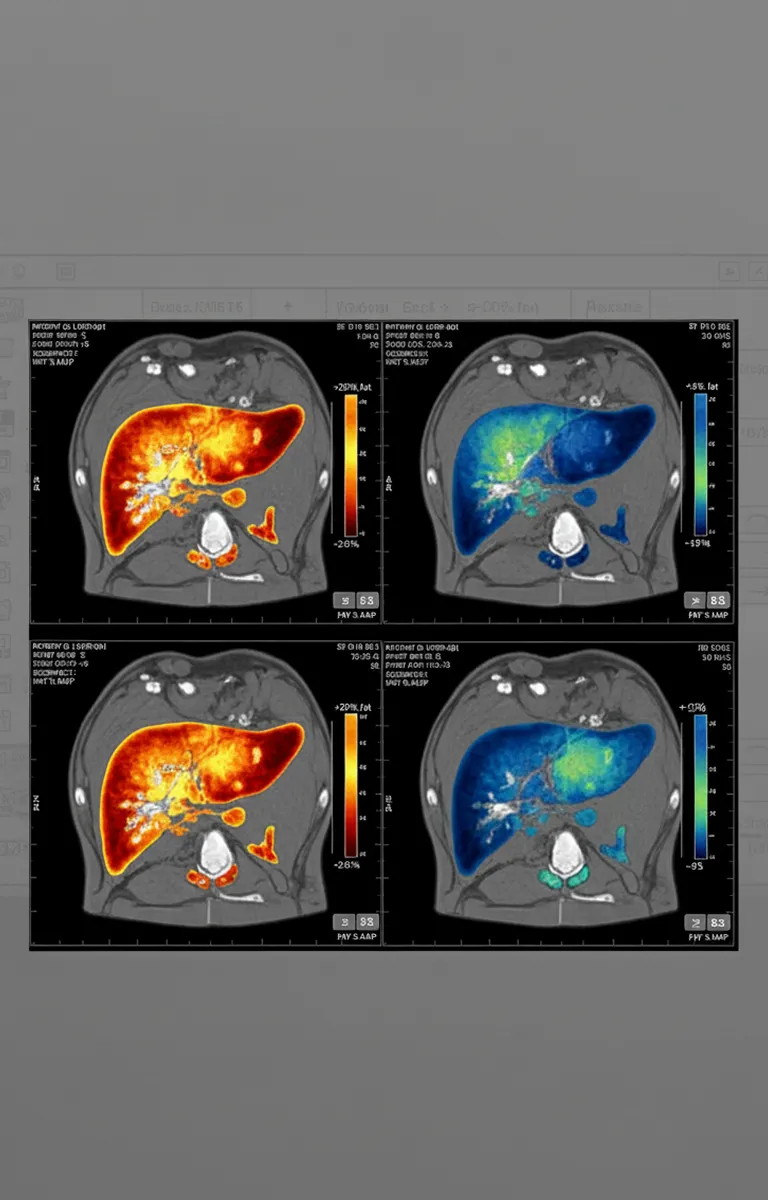Retatrutide and Fatty Liver: How 85% of Patients Saw Liver Fat Disappear
In clinical studies, Retatrutide cut liver fat by up to 85%, a breakthrough that could redefine fatty liver treatment.

Introduction
Fatty liver disease used to be something most people associated with heavy drinking. Not anymore. Today, metabolic dysfunction-associated steatotic liver disease (MASLD), formerly known as non-alcoholic fatty liver disease, affects roughly one in four adults worldwide. It's silent, progressive, and closely tied to obesity and insulin resistance. For years, the only real treatment has been weight loss, which is easier said than done.
That's why recent data on Retatrutide have caught the attention of hepatologists and endocrinologists alike. In a Phase 2a substudy involving patients with MASLD, Retatrutide reduced liver fat by up to 85% after just 24 weeks of treatment. In some participants, MRI scans showed near-complete resolution of fat accumulation. Those aren't incremental improvements. They're the kind of results that could redefine how fatty liver disease is treated.
Understanding MASLD and Its Link to Obesity
MASLD develops when fat accumulates in the liver without significant alcohol consumption. Early stages are relatively harmless, but over time, that fat can trigger inflammation, scarring, and eventually cirrhosis or liver failure. The scary part is that most people with MASLD don't have symptoms until the damage is already advanced.
The condition is strongly linked to metabolic dysfunction, insulin resistance, type 2 diabetes, and obesity. When the body can't properly regulate blood sugar and fat metabolism, excess triglycerides end up stored in the liver. Weight gain, particularly visceral fat around the abdomen, makes the problem worse. It's not just about how much someone weighs, but where that weight sits and how their metabolism handles it.
For a long time, doctors told patients with MASLD to lose weight and exercise more. That advice isn't wrong, but it's incomplete. Many people struggle to lose enough weight on their own to make a meaningful difference. Even bariatric surgery, which is highly effective for weight loss, doesn't always reverse liver damage if it's caught too late. What's been missing is a medication that directly targets the metabolic pathways driving fat accumulation in the liver. Retatrutide appears to do exactly that.
How Triple Hormone Therapy Impacts Liver Fat Accumulation
Retatrutide activates three hormone receptors, GLP-1, GIP, and glucagon, which together influence how the body processes and stores fat. Each pathway plays a role in liver metabolism, but their combined effect seems to be what makes Retatrutide particularly effective for MASLD.
GLP-1 improves insulin sensitivity and reduces appetite, which leads to weight loss. Less body fat generally means less fat deposited in the liver. But GLP-1 alone doesn't directly address existing liver fat. That's where GIP and glucagon come in.
GIP enhances the body's ability to clear triglycerides from the bloodstream and improves how fat cells store and release energy. This reduces the overflow of fat into the liver. Glucagon, meanwhile, promotes fat oxidation, essentially telling the liver to burn stored fat for energy instead of hoarding it. When all three hormones are activated together, the liver starts clearing out accumulated fat while the body simultaneously reduces new fat deposits.
This isn't just theoretical. Imaging studies show measurable reductions in liver fat content within weeks of starting Retatrutide. The liver physically shrinks as fat is mobilized and metabolized. For patients who've struggled with MASLD for years, that kind of reversal is significant.
Key Findings from the Phase 2a Liver Study
Eli Lilly conducted a dedicated Phase 2a trial to evaluate Retatrutide's effects on liver fat in patients with MASLD. Participants had confirmed liver fat content of at least 10% as measured by MRI-PDFF, the gold standard imaging technique. They received either Retatrutide or placebo for 24 weeks.
The results were striking. At the highest doses, MRI scans showed an average liver fat reduction of 81 to 82%. Many participants dropped from clinically significant fatty liver, defined as more than 5% fat content, to normal levels below 5%. Some even reached levels below 3%, which is considered essentially fat-free.
Weight loss played a role, of course. Participants lost an average of 10 to 12% of their body weight over the same period. But the liver fat reduction outpaced what would typically be expected from weight loss alone. That suggests Retatrutide has a direct metabolic effect on the liver beyond simple calorie restriction.
Blood markers also improved. ALT and AST, enzymes that indicate liver inflammation, dropped significantly. So did markers of fibrosis, suggesting that not only was fat being cleared, but early-stage scarring might be reversing as well. Long-term studies will need to confirm whether that translates into reduced progression to cirrhosis, but the early signals are promising.
85% Fat Reduction Explained: What It Means in Real Terms
An "85% reduction in liver fat" sounds dramatic, but what does it actually mean for a patient?
Imagine someone with 15% liver fat content at baseline, well above the 5% threshold for MASLD. After 24 weeks on Retatrutide, that drops to around 2 or 3%. On an MRI, the liver goes from visibly bright with fat deposits to appearing nearly normal. Functionally, the liver starts working more efficiently. Insulin resistance improves. Inflammation decreases. The risk of progression to cirrhosis drops.
For many patients, this also means they no longer meet the diagnostic criteria for MASLD. That's not just a technical distinction. It's the difference between being on a path toward potential liver failure and having a liver that's metabolically healthy again.
It's worth noting that not everyone reached 85% reduction. Individual responses varied based on baseline severity, weight loss, and other factors. But the majority of participants saw clinically meaningful improvements, enough to move from moderate or severe fatty liver to mild or resolved status.
How Retatrutide Compares to Other MASLD Treatments
Currently, there are no FDA-approved medications specifically for MASLD. Treatment relies on managing underlying conditions, controlling diabetes, losing weight, improving diet. Some medications show modest benefits. Pioglitazone, a diabetes drug, can reduce liver fat but causes weight gain. Vitamin E has shown some effect in non-diabetic patients, but results are inconsistent.
GLP-1 drugs like Ozempic and Wegovy help indirectly through weight loss. Studies show semaglutide reduces liver fat by about 30 to 40% over similar timeframes. That's meaningful, but nowhere near the 80%+ reductions seen with Retatrutide.
Tirzepatide (Mounjaro), a dual GLP-1/GIP agonist, performs better, closer to 50 to 60% liver fat reduction in early studies. But Retatrutide, with its added glucagon activity, appears to go further. The glucagon receptor activation seems to be the key differentiator, driving fat oxidation in the liver more aggressively than dual-agonist therapies.
There are other experimental MASLD drugs in development, including FGF21 analogs and thyroid hormone receptor agonists. Some show promise, but they're years away from approval and come with their own side effect profiles. Retatrutide has the advantage of being further along in development and having a well-understood safety profile similar to other incretin-based drugs.
Future Potential for Liver Disease Management
If Phase 3 trials confirm these results, Retatrutide could become the first medication with a specific indication for MASLD. That would be a major shift in how the condition is treated. Instead of relying solely on lifestyle changes that many patients struggle to maintain, doctors could offer a pharmacologic option that directly reverses liver fat accumulation.
Beyond MASLD, there's potential for treating more advanced disease. Metabolic dysfunction-associated steatohepatitis (MASH), the inflammatory form of fatty liver, currently has no effective treatment. If Retatrutide can reduce both fat and inflammation, it might slow or even reverse fibrosis in early-stage MASH patients. That could prevent progression to cirrhosis and reduce the need for liver transplants down the line.
Eli Lilly is already planning larger studies specifically focused on liver outcomes. These trials will track not just imaging markers but clinical endpoints, rates of cirrhosis, liver-related hospitalizations, and mortality. If those results are positive, Retatrutide won't just be a weight-loss drug or a diabetes medication. It could become a cornerstone of liver disease prevention.
There are still questions to answer. How long do patients need to stay on Retatrutide to maintain liver fat reduction? What happens if treatment is stopped? Can it prevent liver cancer in high-risk patients? Those answers will take years to obtain, but the early data provide a strong foundation for optimism.
Conclusion
Fatty liver disease has long been one of the most frustrating conditions to treat. It's common, progressive, and until now, lacked effective pharmacologic options. Retatrutide changes that equation. By targeting multiple metabolic pathways simultaneously, it doesn't just promote weight loss, it directly reverses liver fat accumulation in a way no other drug has demonstrated.
An 85% reduction in liver fat isn't a modest improvement. It's a near-complete resolution for many patients. Combined with improvements in inflammation, fibrosis markers, and overall metabolic health, Retatrutide represents a genuine breakthrough in liver disease management.
Approval is still a few years away, and not every patient will respond equally. But for the millions of people living with MASLD, many of whom don't even know they have it, this could be the treatment they've been waiting for. Not just symptom management, but actual reversal of a disease that's been silently damaging their liver for years.
References
- Sanyal AJ, Kaplan LM, Frias JP, et al. Triple hormone receptor agonist retatrutide for metabolic dysfunction-associated steatotic liver disease: a randomized phase 2a trial. Nat Med. 2024;30(7):2037-2048. doi:10.1038/s41591-024-03018-2
https://pubmed.ncbi.nlm.nih.gov/38858523/ - Jastreboff AM, Kaplan LM, Frías JP, et al. Triple hormone-receptor agonist retatrutide for obesity—a phase 2 trial. N Engl J Med. 2023;389(6):514-526. doi:10.1056/NEJMoa2301972
https://www.nejm.org/doi/full/10.1056/NEJMoa2301972 - Rinella ME, Lazarus JV, Ratziu V, et al. A multisociety Delphi consensus statement on new fatty liver disease nomenclature. Hepatology. 2023;78(6):1966-1986. doi:10.1097/HEP.0000000000000520
https://pubmed.ncbi.nlm.nih.gov/37363821/ - Younossi ZM, Golabi P, Paik JM, et al. The global epidemiology of nonalcoholic fatty liver disease (NAFLD) and nonalcoholic steatohepatitis (NASH): a systematic review. Hepatology. 2023;77(4):1335-1347. doi:10.1097/HEP.0000000000000004
https://pubmed.ncbi.nlm.nih.gov/36626630/ - Eli Lilly and Company. A Study of Retatrutide (LY3437943) in Participants With Obesity or Overweight (TRIUMPH-1). ClinicalTrials.gov Identifier: NCT04881760.
https://clinicaltrials.gov/study/NCT04881760 - Rinella ME, Neuschwander-Tetri BA, Siddiqui MS, et al. AASLD Practice Guidance on the clinical assessment and management of nonalcoholic fatty liver disease. Hepatology. 2023;77(5):1797-1835. doi:10.1097/HEP.0000000000000323
https://pubmed.ncbi.nlm.nih.gov/36727674/
Frequently Asked Questions
MASLD stands for metabolic dysfunction-c liver disease. It's the new medical term for what used to be called non-alcoholic fatty liver disease (NAFLD). The name change reflects the understanding that it's driven by metabolic problems like insulin resistance and obesity, not just the absence of alcohol. The disease itself is the same, fat accumulation in the liver that can lead to inflammation and scarring if left untreated.
In many cases, yes. Clinical trial data show that most patients on higher doses reached liver fat levels below 5%, which is considered resolution of MASLD. Some dropped below 3%, essentially achieving a normal, healthy liver on imaging. However, maintaining those results likely requires continued treatment and lifestyle management. Long-term data on sustained remission after stopping Retatrutide aren't yet available.
No. The Phase 2a liver study included patients with moderate to high liver fat but not necessarily advanced disease. Retatrutide appears effective across a range of MASLD severity. That said, people with cirrhosis or advanced liver damage were excluded from early trials, so it's unclear how well it works in late-stage disease. Future studies will explore that population.
Eli Lilly is currently running Phase 3 trials, with FDA submission expected in 2026. If approved first for obesity or diabetes, doctors may prescribe it off-label for MASLD patients in the meantime. A specific liver disease indication would likely come later, possibly 2027 or beyond, pending results from dedicated liver outcome trials.
Related Topics
Evidence-based articles to support your journey toward sustainable health.
Register your interest in Retatrutide
Retatrutide is currently not available, but once it is approved, you’ll be the first to get notified. Sign up now and stay informed.
Simple one-time sign-up
Early access to availability updates
Exclusive status among the first users
Advantage over non-registered users
%201.webp)
.svg)



